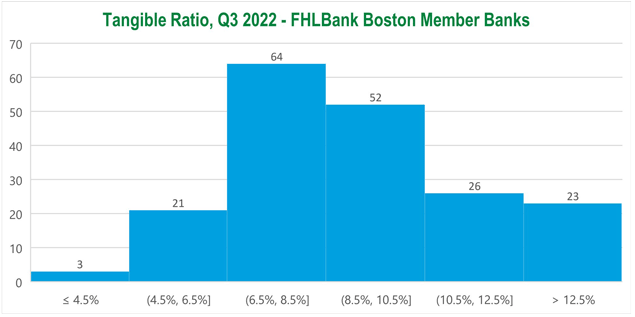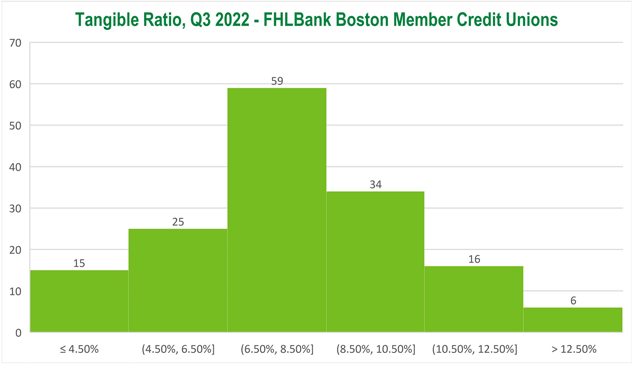Identifying and Managing Tangible Capital
Declining tangible equity could impact a depository’s credit status category at FHLBank Boston through legacy regulation. As of December 9, 2022, FHLBank Boston policies dependent on specific tangible equity ratios were changed to no longer automatically affect a member’s credit status category. Borrowing restrictions for any institution with negative tangible equity remain.
Tangible Capital vs. Regulatory Capital
Coming out of the Great Recession, banks had a revised international framework for assessing bank capital and liquidity. The new framework introduced Common Equity Tier 1 (CET1) as a fourth capital ratio. By excluding goodwill and many intangible assets from its definition of capital, CET1 largely replaced tangible capital as a reference point for a number of parties. Additionally, the new framework allowed all but the largest institutions to make a one-time opt-out decision to exclude Accumulated Other Comprehensive Income (AOCI) from capital ratios.
The Federal Housing Finance Agency (FHFA), which is FHLBank Boston’s regulator, did not change its framework to align with these other industry changes, however. As a result, FHLBank Boston’s primary assessment of capital adequacy remains tangible equity-to-assets (tangible ratio), which is inclusive of AOCI. AOCI is itself predominantly a function of unrealized gains and losses on Available-for-Sale (AFS) investment securities.
Because of the rapid increase in interest rates this year, essentially all institutions with AFS securities have seen significant losses and, as a result, tangible ratios have declined. The larger the AFS portfolio and the longer the duration, the more significant the decline.
Credit Status Category – How Tangible Capital Directly Impacts Members
Bank and credit union members of FHLBank Boston are assigned a credit status category based on an overall assessment of financial condition that determines the level of documentation required for pledging loan collateral and the lendable value of those assets.
- Category 1 depositories may opt to file Qualified Collateral Reports (QCRs) that allow the member to pledge only totals on owner-occupied, one- to four-family residential mortgages;
- Category 2 depositories must list all loans in a format approved by FHLBank Boston; and
- Category 3 depositories must list and deliver all loans to FHLBank Boston.
Additionally, Category 3 members need to apply to take any new advance with a term of one year or more through a Supplement A form.
Depositories should understand where their tangible ratios stand and then estimate the impact to their tangible ratio based on a given move in interest rates.
Hard limits on specific tangible ratios no longer necessarily determine a member’s credit status category. Any member with a negative tangible ratio, however, is ineligible to take new borrowings unless the member’s primary regulator submits a waiver on its behalf. Members with a negative tangible equity ratio but sufficient collateral may renew maturing advances for a term of no more than 30 days.
Assess the Risk First, Then Consider Gameplans
Depositories should understand where their tangible ratios stand and then estimate the impact to their tangible ratio based on a given move in interest rates.
Since they are not subject to income taxes, credit unions see faster changes to their tangible ratios than banks because AOCI is not moderated by a tax shield.


Generally sheer size of the AFS investment book as a percentage of assets is the single greatest element of downside risk to tangible capital. As of third quarter of 2022, that metric at member banks and credit unions with total assets below $100 billion was 15.9% and 9.8%, respectively. A minority of members has levels greatly exceeding these averages, however. About 17% of that same cohort of member banks and 10% of member credit unions have AFS books that exceed 25% of assets.
While all should understand the dynamics of the concern, most institutions have minimal risk from this issue because their AFS book as a percentage of assets is smaller than their surplus tangible capital.
For those that need to more closely monitor their exposure, however, a comparison of the horserace of organic earnings power to potential yield curve risk and the passage of time would be beneficial. All else equal, time reduces duration and portfolio principal, resulting in lower risk.
“Tangible” Resources for Members
FHLBank Boston crafted a tool that members can use that estimates what move in interest rates would have to occur before an institution breaches the credit status category thresholds. Most will find that only very extreme interest-rate moves put them at risk.
Below are three tables that provide an example of a hypothetical $1 billion bank member that presently has a tangible ratio slightly above 7%.
| Input | Value |
|---|---|
| Total Equity | $80,000,000 |
| Total Assets | $1,000,000,000 |
| Intangibles | $10,000,000 |
| AFS Portfolio | $150,000,000 |
| Duration | 6.0 |
| Tax Rate | 26% |
| Annualized DOE, Total Equity | 9.0% |
| Tangible Calculation | Results |
|---|---|
| Tangible Equity | $70,000,000 |
| Tangible Assets | $900,000,000 |
| Tangible Ratio | 7.07% |
| Time Period | Tangible Ratio (4.5%) | Sell Bonds at a Loss | Use Member-Option Advance |
|---|---|---|---|
| Single Quarter | 4.31% | 5.88% | 11.36% |
| Two Quarters | 4.51% | 6.14% | 11.88% |
| Three Quarters | 4.72% | 6.44% | 12.44% |
| One Year | 4.96% | 6.76% | 13.06% |
In the hypothetical example above, rates would have to move up 5.88% before hitting a tangible ratio of 3.5% and an increase of 11.36% in bond yields in a single quarter before their tangible ratio would go become negative.
The dollar threshold calculations include the value of earnings over the time horizon indicated (based on the ROE user input), and the yield curve change thresholds contemplate both the effect of the tax shield on AOCI plus the organic reduction in duration over the time horizon indicated.
Strategies for Management
If a judicious course of inaction isn’t a viable path, institutions could assess alternative strategies depending upon their position and risk tolerances.
| Strategy | Effectiveness | P&L Impact | Trade-Offs |
|---|---|---|---|
| Off-setting swaps | Potentially fully effective | Likely none | Counterparty risk, operational risk |
| Re-class Available-for-Sale to Held-to Maturity, or sell securities | Potentially fully effective | Substantial | Future accounting restrictions, tax implications, improved earn-out w/ replacement assets at higher yields |
| Deleverage | Low, relative to rate risk | Ambiguous | Opportunity cost of franchise development |
| Pledge underwater securities | High for borrowing capacity, Zero for tangible ratio management | None | Operational risk |
Strategy 1: Enter Into Off-setting Swaps
This strategy could partially or fully neutralize the issue depending upon the notional and terms selected without needing to recognize loss on the income statement. Depending upon trading terms, the trade-off is the potential introduction of counterparty risk and operational risks, especially with collateral management. For members comfortable with derivatives, this can be an effective option.
Strategy 2: Move Securities to Held-to-Maturity – Or Sell Outright
This tactic most directly and immediately sterilizes the issue at the cost of recognizing losses through the income statement. Members should consult their accountants or auditors, but re-classifying securities memorializes a loss at what could prove to be an unfavorable moment and could limit their ability to make future changes to their investments.
Strategy 3: Deleverage the Balance Sheet
Deleveraging the balance sheet must come from the liability side, but with deposits declining throughout the industry, this could be happening organically at any given institution. Relative to the first two options, however, there is relatively low pound-for-pound value. Though it depends on a variety of variables, a depository with a tangible ratio at 5% could reduce assets by 10% and see approximately 55 bps of improvement in the tangible ratio; with an AFS book at 25% of assets, that improvement would be offset by only a 41 bps move in rates at a credit union or a 55 bps move at a bank.
Strategy 4: Increase Borrowing Capacity by Pledging Underwater Securities
Though this strategy doesn’t mitigate the possibility of declining tangible ratios, it does help to mitigate the risk of potentially worsening haircuts on loans, especially in an economic environment and real estate market that may be deteriorating. Regardless of credit status category, members need to list and deliver securities to borrow against them, but preserving, or even expanding, borrowing capacity in a time of falling liquidity could be beneficial.
Flexible Solutions
Recent market conditions have created challenges and opportunities for FHLBank Boston members. Our Financial Strategies group has developed a suite of analytical tools designed to help you. For more details about these tools or managing tangible capital, please contact Andrew Paolillo at 617-292-9644 or andrew.paolillo@fhlbboston.com or reach out to your relationship manager for more details.
FHLBank Boston does not act as a financial advisor, and members should independently evaluate the suitability and risks of all advances. The content of this article is provided free of charge and is intended for general informational purposes only. FHLBank Boston does not guarantee the accuracy of third-party information displayed in this article, the views expressed herein do not necessarily represent the view of FHLBank Boston or its management, and members should independently evaluate the suitability and risks of all advances. Forward-looking statements: This article uses forward-looking statements within the meaning of the “safe harbor” provisions of the Private Securities Litigation Reform Act of 1995 and is based on our expectations as of the date hereof. All statements, other than statements of historical fact, are “forward-looking statements,” including any statements of the plans, strategies, and objectives for future operations; any statement of belief; and any statements of assumptions underlying any of the foregoing.. The words “expects”, “may”, “likely”, “could”, “to be”, “will,” and similar statements and their negative forms may be used in this article to identify some, but not all, of such forward-looking statements. The Bank cautions that, by their nature, forward-looking statements involve risks and uncertainties, including, but not limited to, the uncertainty relating to the timing and extent of FOMC market actions and communications; economic conditions (including effects on, among other things, interest rates and yield curves); and changes in demand and pricing for advances or consolidated obligations of the Bank or the Federal Home Loan Bank system. The Bank reserves the right to change its plans for any programs for any reason, including but not limited to legislative or regulatory changes, changes in membership, or changes at the discretion of the board of directors. Accordingly, the Bank cautions that actual results could differ materially from those expressed or implied in these forward-looking statements, and you are cautioned not to place undue reliance on such statements. The Bank does not undertake to update any forward-looking statement herein or that may be made from time to time on behalf of the Bank.


